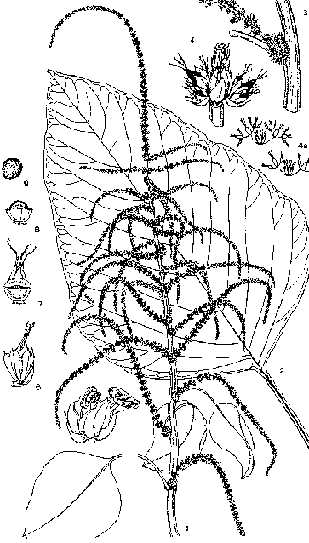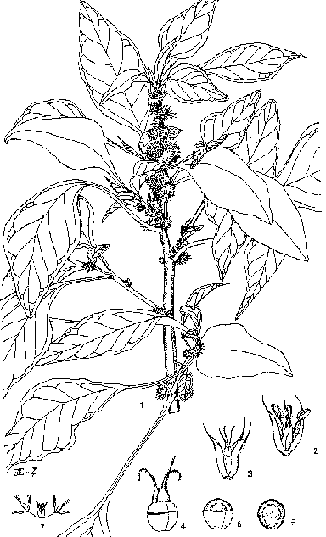Vegetable Amaranths[edit | edit source]
Most Amaranthus species have edible leaves, and several species are already widely used as potherbs (boiled greens). Over the years, growers have selected types with leaves and stems of high palatability. Their mild spinach-like flavor, high yields, ability to grow in hot weather, and high nutritive value have made them popular vegetable crops, perhaps the most widely eaten vegetables in the humid tropics. In some African societies, for example, protein from amaranth leaves provides as much as 25 percent of the daily protein intake during the harvest season.
In many tropical regions of India, China, Southeast Asia, and the South Pacific islands, amaranths, such as Amaranthus tricolor and Amaranthus dubius, are grown. They have been cultivated for more than 2,000 years, and many different cultivars, some with brightly colored leaves, have been developed. In humid tropical Africa, Amaranthus cruentus is extensively grown as a leaf vegetable. In much of the Caribbean, Amaranthus dubius and other amaranths are considered among the best of leafy greens.
In temperate regions of Eurasia, amaranths have long been domesticated as leafy vegetables, as were their relatives, spinach and chard. Amaranthus lividus, a low-growing, succulent, purplish-red herb, was cultivated in the gardens of ancient Greece and Rome and in medieval Europe. In North American deserts, Indians subsisted on Amaranthus palmer) and Amaranthus hybridus until corn and beans could be harvested. They were the only summer leafy vegetables with a dependable yield in the hot and arid conditions.
Despite the fact that vegetable amaranths are cultivated or gathered in so many regions, few references include more than generalities about their culture. This may indicate both their ease of cultivation and the fact that, because of wide adaptability, the optimal conditions for maximum yields are not known. Often the seeds are not sown at all and natural seed fall provides the following year's crop.
Since the plants grow rapidly, the time between planting and harvest of the tender foliage and stems is short-generally only 3-6 weeks. In Tamil Nadu (South India) plants are pulled 3 weeks after sowing and used as "tender greens." Certain varieties remain succulent longer and can be harvested after up to 5 weeks of growth. Varieties suitable for periodical cutting (clipping) are also available. The first cutting is done at 20 days after sowing, and thereafter weekly cuttings are possible for up to 10 cuttings. At a later age, and particularly after the flowers develop, the foliage and stems become fibrous, brittle, pithy, and unpalatable.
AMARANTHUS CRUENTUS
This species has been described earlier as a grain type. A very deepred, dark-seeded form of the species, sometimes known as blood amaranth, is often sold as an ornamental in commercial seed packets. During the nineteenth century, this deep-red form was adopted for use as cooked greens by gardeners throughout the tropics. It became a more important crop in tropical Africa than anywhere else. Like corn, sweet potatoes, peanuts, and other American Indian crops, Amaranthus cruentus was evidently introduced to Africa by Europeans. But then it passed quickly from tribe to tribe, probably as a weed in millet and sorghum seed. It outran European exploration of the interior, so that Livingstone and others found it already in cultivation when they arrived. Today it is being planted and gathered year-round in the humid regions of much of Africa. In parts of West Africa, for instance, the tender young seedlings are pulled up by the roots and sold in town markets by the thousands of tons every year.
AMARANTHUS DUBIUS
This weedy species is used as a green vegetable in West Africa and the Caribbean and is found in Java and other parts of Indonesia as a home garden crop. One of the best varieties of this species, known as the cultivar "claroen," is particularly popular in Benin and Suriname. Its seeds are extremely small (4,500 seeds per g). It has distinctive dark-green, broad, ridged leaves. It is fast growing, high yielding, and has considerable morphological variation, resulting partly from its repeated hybridization with Amaranthus spinosus. The "greens" of this species are considered very palatable. This is the only tetraploid (2n = 64) species in the genus known so far.
AMARANTHUS HYBRIDUS
This weedy species is one of the most common leafy vegetables. It is an herb that grows up to 1.5 m tall. Originating in tropical America, it is now spread throughout tropical areas. In Indonesia it is often planted in kitchen gardens. It also grows wild on moist ground, in waste places, or along roadsides, and thrives in altitudes up to 1,300 m.
In the markets, bundles of leafy shoots as well as uprooted young plants are offered for sale.
The tender leaves and young seedlings are used widely in soups and stews. Lamb, beef, chicken, or pork is often added.
The common name of the plant in Mexico is quintonil. Elsewhere it is known as phak khom (Thailand), bayam (Malaysia, Indonesia), urai (Philippines), and slender amaranth.
The size and color vary greatly. Red-stemmed varieties are usually planted as ornamentals; green varieties are commonly used as vegetables.
Amaranthus hybridus has potential to impart early maturity to grain types through crossbreeding.
AMARANTHUS DUBIUS
AMARANTHUS LIVIDUS
This widely distributed species (also known as A. blitum) is well adapted to temperate climates and has a number of weedy forms that come with either red or green leaves. It promises to allow the development of highly palatable crossbred vegetable amaranths. In
Madhya Pradesh, India, the edible forms, known as norpa, are especially liked for their tender stems. This is the species widely eaten in Greece under the name vleeta. It is also grown in Taiwan, where it is known as horsetooth amaranth.
AMARANTHUS TRICOLOR
Varieties of this species are native to a large area from India to the islands of the Pacific and as far north as China. It is probably the best-developed of the vegetable amaranth species.
The plants are succulent, low growing, and compact, with growth habits much like spinach.
They can be produced as a hot-season leafy vegetable in arid regions when few other leafy greens are available. In India a number of domesticated forms are available, especially in
Andhra Pradesh, Karnataka, Tamil Nadu, and Kerala. Some ornamentals with very beautiful foliage also belong to this species.
NUTRITIONAL QUALITY
The nutritional quality of amaranth greens is similar to that of other leafy vegetables.
However, because their dry-matter content is often high, an equivalent amount of fresh amaranth often provides from 2 to 3 times the amount of nutrients found in other vegetables (see Table 3). In mineral content, notably iron and calcium, amaranth greens rank particularly well when measured against other potherbs.
Leaf-protein levels (dry-weight basis) have been reported as 27 percent for Amaranthus blitum, 28 percent for Amaranthus hybridus, 30 percent for Amaranthus caudatus, and 33 percent for Amaranthus tricolor.* The amino acid composition of Amaranthus hybridus leaf protein shows a chemical score of 71, which is comparable to that of spinach.
High levels of the nutritionally critical amino acids lysine and methionine have been found in the leaves of 13 amaranth species.+ Vegetable amaranths are also an important source of vitamins, especially vitamin A, the lack of which results in a most serious nutritional deficiency in the tropics and leads to blindness in thousands of children each year.
AMARANTHUS TRICOLOR
TABLE 3 Nutrient Content(a) of Selected Raw Vegetable Leaves(b)
|
Malabar spinach |
||||
|
Component |
Amaranth |
Spinach |
(Basella) |
Chard |
|
Dry matter, g |
13.1 |
9.3 |
6.9 |
8.9 |
|
Food energy, cat |
36 |
26 |
19 |
25 |
|
Protein, g |
3.5 |
3.2 |
1.8 |
2.4 |
|
Fat, g |
0.5 |
0.3 |
0.3 |
0 3 |
|
Carbohydrates |
||||
|
Total, g |
6.5 |
4.3 |
3.4 |
4.6 |
|
Fiber, g |
1.3 |
0.6 |
0.7 |
0.8 |
|
Ash, g |
2.6 |
1.5 |
1.4 |
1.6 |
|
Calcium, mg |
267 |
93 |
109 |
88 |
|
Phosphorus, mg |
67 |
51 |
52 |
39 |
|
Iron, mg |
3.9 |
3.1 |
1.2 |
3.2 |
|
Sodium, mg |
. . . |
71 |
. . . |
14.7 |
|
Potassium, mg |
411 |
470 |
. . . |
550 |
|
Vitamin A, IU |
6,100 |
8,100 |
8,000 |
6,500 |
|
Thiamin, mg |
0.08 |
0.10 |
0.05 |
0.06 |
|
Riboflavin, mg |
0.16 |
0.20 |
. . . |
0.17 |
|
Niacin, mg |
1.4 |
0.6 |
0.5 |
0.5 |
|
Vitamin C, mg |
80 |
51 |
102 |
32 |
(a) Per 100 g of edible portion
(b) From Watt and Merrill, 1963
Source: Saunders and Becker, 1983
YlELD
Generally, yields are in the range of 4 to 14 tons per ha green weight. However, vegetable amaranth yields have been reported as high as 40 tons per ha.
Fertilization, especially with nitrogen, is one of the major factors influencing yield, although few, if any, fertility trials have been done and there is little data for different growing regimens or locales.
Regrowth can provide four or more harvests a year. In Benin, it has been suggested that the plants be cut when they reach a height of 20 cm and that the harvest interval should be 3 weeks.
DISEASES AND PESTS
Insect and disease problems can seriously affect vegetable amaranths. The plants do not grow well during long periods of cloudy, wet weather and are not tolerant of shade. During a monsoon rainy season, for example, damping-off from Pythium and Rhizoctonia is most serious. Another disease, Choanephora cucurbitarum, causes wet rot in leaves and young stalks.
To reduce such fungal diseases, seedbeds (especially those established during humid weather) must be well drained and located in sunny sites. Manuring can eliminate some of the problems. Various fungicides have also been used successfully.
Insect damage can be a more serious problem for vegetable amaranths than for grain amaranths. The major pests are larvae of moths and butterflies, as well as leaf hoppers, leaf miners, grasshoppers, and leaf-feeding beetles.
Slugs and snails also often severely damage young plantings.
LIMITATIONS
Green leafy vegetables are known to contain a wide variety of antinutritional factors.
Amaranth is no exception. Oxalic acid, betacyanins, alkaloids such as betaine, cyanogenic compounds, saponins, sesquiterpenes, and polyphenols all have been reported present in various species.
Like many other fast-growing plants, amaranth requires and absorbs large amounts of nitrate. Under certain conditions, nitrate accumulates to levels that constitute several percent of plant dry matter. The levels, however, are about the same as those in spinach, beet greens, chard, and other conventional potherbs. Boiling the leaves removes most of the nitrate.
Green leafy vegetables, including amaranth, also frequently contain large quantities of oxalic acid. Oxalic acid is an end product of metabolic processes and accumulates as the plant gets older. When eaten by humans, it binds some minerals, notably calcium, and makes these unavailable for absorption from the digestive tract, so that a person consuming sufficiently large amounts of them develops a mineral deficiency.
The oxalic acid levels in amaranth samples can be uncomfortably high (1-2 percent), particularly when the plant is grown under dry conditions. The levels are affected by soil fertility and increase with fertilization. It is because of oxalic acid that amaranths (and many other leafy greens) are boiled before eating. (Boiling makes amaranths nontoxic, because the oxalic acid dissolves in the water.)
FORAGE
The fact that boiled amaranth leaves have been an important component of the human diet in many African and southern Asian countries for centuries suggests that it might also be a useful forage crop for animals, particularly ruminants.
Extensive studies to confirm this have not been conducted, and there are a number of reports in the veterinary literature that implicate species of wild amaranth in the poisoning of livestock. However, these incidents were under dry conditions where weedy amaranths are known to accumulate high levels of nitrate and oxalates and where they survive better than other plants, so the animals could not balance their diet. These observations raise some concern over the possible usefulness of amaranth as a forage crop; research to resolve the issue is well warranted.
LEAF-PROTEIN ISOLATES
A future promise of vegetable amaranths is the development of leafprotein concentrates. Compared with most other species, amaranth leaf protein is highly extractable. In one trial, amaranth had the highest level of extractable protein among 24 plant species studied.
During the extraction of leaf protein, most other nutrients are extracted as well: for example, provitamin A (beta-carotene), polyunsaturated lipids (linoleic acid), and iron. Heating or treating the extract with acid precipitates the nutrients as leaf-protein concentrate. In the process, most of the harmful compounds are eliminated, as they remain in the soluble phase. The green cheeselike coagulum is washed with water slightly acidified with dilute acetic acid (vinegar) to further reduce the amounts of possible antinutritive factors. The resulting leaf-nutrient concentrate is especially useful for young children and other persons with particularly high protein, vitamin A, and iron needs. The fibrous pulp left after extracting the amaranth greens is a suitable feed for animals.
The protein quality of the amaranth leaf-nutrient concentrate (determined by amino acid composition, digestibility, and nutritional effectiveness) is excellent. It is, however, species dependent, probably because of the presence of secondary substances in some species.


